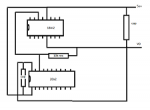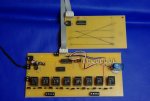Hi all
I've built two small circuits that are connected together with a ribbon cable that provided V+ and V- between both boards from the same on board power supply.
On the main board the axe is a 20x2, and on the secondary board the axe is an18m2 and they are connected together again via the ribbon cable from port C.7 on the 18m2 to port B.0 on the 20x2.
I want to get the 18m2 to talk to the 20x2 via the connection using serout and serin commands but for some reason although I can see the data leaving the 18m2 with a voltmeter, the 20x2 will not respond. I've checked and triple checked my wiring and connections which all seem to be ok.
The code I'm using is ......
on the 18m2 data out
and on the 20x2 data in
I've tried changing the baud rates and frequency but all to no avail.
Can anyone spot the obvious mistake ?????
And yes the input does have a 10k to earth
All suggestions gratefully received
I've built two small circuits that are connected together with a ribbon cable that provided V+ and V- between both boards from the same on board power supply.
On the main board the axe is a 20x2, and on the secondary board the axe is an18m2 and they are connected together again via the ribbon cable from port C.7 on the 18m2 to port B.0 on the 20x2.
I want to get the 18m2 to talk to the 20x2 via the connection using serout and serin commands but for some reason although I can see the data leaving the 18m2 with a voltmeter, the 20x2 will not respond. I've checked and triple checked my wiring and connections which all seem to be ok.
The code I'm using is ......
on the 18m2 data out
Code:
ons:
high B.0
b2=1
serout C.7,n1200_8,(b2)
pause 10
serout C.7,n1200_8,(b2)
pause 10
goto main1
Code:
start:
serin B.0,n1200_8,b2
if b2=1 then goto main
goto startCan anyone spot the obvious mistake ?????
And yes the input does have a 10k to earth
All suggestions gratefully received


